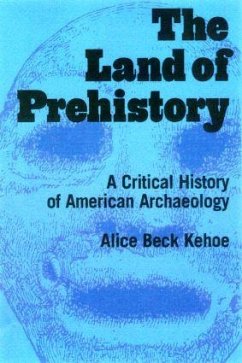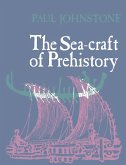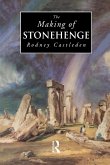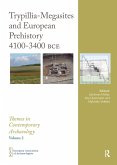- Broschiertes Buch
- Merkliste
- Auf die Merkliste
- Bewerten Bewerten
- Teilen
- Produkt teilen
- Produkterinnerung
- Produkterinnerung
First published in 1998. Routledge is an imprint of Taylor & Francis, an informa company.
Andere Kunden interessierten sich auch für
![The Sea-Craft of Prehistory The Sea-Craft of Prehistory]() Paul JohnstoneThe Sea-Craft of Prehistory73,99 €
Paul JohnstoneThe Sea-Craft of Prehistory73,99 €![The Making of Stonehenge The Making of Stonehenge]() Rodney CastledenThe Making of Stonehenge70,99 €
Rodney CastledenThe Making of Stonehenge70,99 €![The Cycladic and Aegean Islands in Prehistory The Cycladic and Aegean Islands in Prehistory]() Ina BergThe Cycladic and Aegean Islands in Prehistory53,99 €
Ina BergThe Cycladic and Aegean Islands in Prehistory53,99 €![The Prehistory of Denmark The Prehistory of Denmark]() Jorgen JensenThe Prehistory of Denmark59,99 €
Jorgen JensenThe Prehistory of Denmark59,99 €![The Prehistory Of Scotland The Prehistory Of Scotland]() V. Gordon ChildeThe Prehistory Of Scotland70,99 €
V. Gordon ChildeThe Prehistory Of Scotland70,99 €![Trypillia Mega-Sites and European Prehistory Trypillia Mega-Sites and European Prehistory]() Trypillia Mega-Sites and European Prehistory87,99 €
Trypillia Mega-Sites and European Prehistory87,99 €![Neolithic Neolithic]() Susan McCarterNeolithic53,99 €
Susan McCarterNeolithic53,99 €-
-
-
First published in 1998. Routledge is an imprint of Taylor & Francis, an informa company.
Hinweis: Dieser Artikel kann nur an eine deutsche Lieferadresse ausgeliefert werden.
Hinweis: Dieser Artikel kann nur an eine deutsche Lieferadresse ausgeliefert werden.
Produktdetails
- Produktdetails
- Verlag: Routledge
- Seitenzahl: 306
- Erscheinungstermin: 27. August 1998
- Englisch
- Abmessung: 229mm x 152mm x 17mm
- Gewicht: 446g
- ISBN-13: 9780415920551
- ISBN-10: 0415920558
- Artikelnr.: 21697349
- Herstellerkennzeichnung
- Libri GmbH
- Europaallee 1
- 36244 Bad Hersfeld
- gpsr@libri.de
- Verlag: Routledge
- Seitenzahl: 306
- Erscheinungstermin: 27. August 1998
- Englisch
- Abmessung: 229mm x 152mm x 17mm
- Gewicht: 446g
- ISBN-13: 9780415920551
- ISBN-10: 0415920558
- Artikelnr.: 21697349
- Herstellerkennzeichnung
- Libri GmbH
- Europaallee 1
- 36244 Bad Hersfeld
- gpsr@libri.de
Alice Beck Kehoe is Professor of Anthropology at Marquette University. She is the author of Humans: An Introductionto Four-Field Anthropology (1998), published by Routledge. She has served the Society for American Archaeology as Public Relations Committee Chair and on its Public Education Task Force, and was nominated for President, Archaeology Division of the American Anthropological Association.
Introduction Chapter 1: The Construction of the Science of Archaeology
Daniel Wilson models a science of prehistory on geology and the
pre-Darwinian evolution of his mentor Robert Chambers of Edinburgh. Chapter
2: Science Boldly Predicts Behind Wilson's science of prehistory were the
Scottish reformers George Combe and Robert Chambers; opposed to the Scots
was the London scientific Establishment led by Sir John Lubbock.
Nineteenth-century mainstream science boldy predicts. Chapter 3:
Consolidating Prehistory Comparing Wilson's Prehistoric Man with Lubbock's
rival volume, it is Lubbock's more purely ideological, racist statements
that, coupled with his influential social position, won his Pre-historic
Times its place in the Whig histories of archaeology. Chapter 4: America's
History A detailed examination of Wilson's presentation of American
prehistory, in which he recognizes the civilizations of American Indian
nations. Chapter 5: Positivists of the New Frontier Professional American
archaeology took off at the time when Turner announced that the physical
frontier was at last closed, challenging Americans to go to new internal
frontiers of research and economic development. American archaeology used
positivist science to investigate the trans-frontier Land of Prehistory.
Chapter 6: Petrified Puddle Ducks Walter Taylor's 1948 monograph acidly
criticized contemporary American archaeology. Chapter 7: The New
Archaeology Ten years after Taylor, Lewis Binford launched an attack on
American archaeology. Carefully planned strategies and rhetoric blatantly
dressing up proposals as Big Science gained National Science Foundation
funding and made older archaeologists look naive. Chapter 8: The Philosophy
of the New Archaeology An analysis of the much-touted philosophy of science
of the New Archaeology. Chapter 9: Cahokia: Hidden in Plain Sight
Mainstream American archaeologists' treatment of Cahokia, the awesome
capital of an eleventh-century Midwestern state, reveals how powerfully
Manifest Destiny ideology still affects American archaeology. Chapter 10:
Burrowing Through the Chiefdom Lewis Henry Morgan's origin myth for
American industrial capitalism is carried on through White, Service, and
their students such as Timothy Earle. Chapter 11: The Taboo Topic
Mainstream American archaeology absolutely refuses to discuss prehistoric
contacts across salt water, even across the Gulf of Mexico. This legacy
from Wilson's interpretation of American prehistory has been reinforced by
Manifest Destiny ideology. Chapter 12: Land of Prehistory Postmodernists,
sociologists of science, and many members of America's First Nations show
little confidence in archaeologists' capacity to study the past. This final
chapter outlines an approach to archaeological data that recognizes the
social construction of knowledge without discounting empiricism or
denigrating First Nations' own historical universes.
Daniel Wilson models a science of prehistory on geology and the
pre-Darwinian evolution of his mentor Robert Chambers of Edinburgh. Chapter
2: Science Boldly Predicts Behind Wilson's science of prehistory were the
Scottish reformers George Combe and Robert Chambers; opposed to the Scots
was the London scientific Establishment led by Sir John Lubbock.
Nineteenth-century mainstream science boldy predicts. Chapter 3:
Consolidating Prehistory Comparing Wilson's Prehistoric Man with Lubbock's
rival volume, it is Lubbock's more purely ideological, racist statements
that, coupled with his influential social position, won his Pre-historic
Times its place in the Whig histories of archaeology. Chapter 4: America's
History A detailed examination of Wilson's presentation of American
prehistory, in which he recognizes the civilizations of American Indian
nations. Chapter 5: Positivists of the New Frontier Professional American
archaeology took off at the time when Turner announced that the physical
frontier was at last closed, challenging Americans to go to new internal
frontiers of research and economic development. American archaeology used
positivist science to investigate the trans-frontier Land of Prehistory.
Chapter 6: Petrified Puddle Ducks Walter Taylor's 1948 monograph acidly
criticized contemporary American archaeology. Chapter 7: The New
Archaeology Ten years after Taylor, Lewis Binford launched an attack on
American archaeology. Carefully planned strategies and rhetoric blatantly
dressing up proposals as Big Science gained National Science Foundation
funding and made older archaeologists look naive. Chapter 8: The Philosophy
of the New Archaeology An analysis of the much-touted philosophy of science
of the New Archaeology. Chapter 9: Cahokia: Hidden in Plain Sight
Mainstream American archaeologists' treatment of Cahokia, the awesome
capital of an eleventh-century Midwestern state, reveals how powerfully
Manifest Destiny ideology still affects American archaeology. Chapter 10:
Burrowing Through the Chiefdom Lewis Henry Morgan's origin myth for
American industrial capitalism is carried on through White, Service, and
their students such as Timothy Earle. Chapter 11: The Taboo Topic
Mainstream American archaeology absolutely refuses to discuss prehistoric
contacts across salt water, even across the Gulf of Mexico. This legacy
from Wilson's interpretation of American prehistory has been reinforced by
Manifest Destiny ideology. Chapter 12: Land of Prehistory Postmodernists,
sociologists of science, and many members of America's First Nations show
little confidence in archaeologists' capacity to study the past. This final
chapter outlines an approach to archaeological data that recognizes the
social construction of knowledge without discounting empiricism or
denigrating First Nations' own historical universes.
Introduction Chapter 1: The Construction of the Science of Archaeology
Daniel Wilson models a science of prehistory on geology and the
pre-Darwinian evolution of his mentor Robert Chambers of Edinburgh. Chapter
2: Science Boldly Predicts Behind Wilson's science of prehistory were the
Scottish reformers George Combe and Robert Chambers; opposed to the Scots
was the London scientific Establishment led by Sir John Lubbock.
Nineteenth-century mainstream science boldy predicts. Chapter 3:
Consolidating Prehistory Comparing Wilson's Prehistoric Man with Lubbock's
rival volume, it is Lubbock's more purely ideological, racist statements
that, coupled with his influential social position, won his Pre-historic
Times its place in the Whig histories of archaeology. Chapter 4: America's
History A detailed examination of Wilson's presentation of American
prehistory, in which he recognizes the civilizations of American Indian
nations. Chapter 5: Positivists of the New Frontier Professional American
archaeology took off at the time when Turner announced that the physical
frontier was at last closed, challenging Americans to go to new internal
frontiers of research and economic development. American archaeology used
positivist science to investigate the trans-frontier Land of Prehistory.
Chapter 6: Petrified Puddle Ducks Walter Taylor's 1948 monograph acidly
criticized contemporary American archaeology. Chapter 7: The New
Archaeology Ten years after Taylor, Lewis Binford launched an attack on
American archaeology. Carefully planned strategies and rhetoric blatantly
dressing up proposals as Big Science gained National Science Foundation
funding and made older archaeologists look naive. Chapter 8: The Philosophy
of the New Archaeology An analysis of the much-touted philosophy of science
of the New Archaeology. Chapter 9: Cahokia: Hidden in Plain Sight
Mainstream American archaeologists' treatment of Cahokia, the awesome
capital of an eleventh-century Midwestern state, reveals how powerfully
Manifest Destiny ideology still affects American archaeology. Chapter 10:
Burrowing Through the Chiefdom Lewis Henry Morgan's origin myth for
American industrial capitalism is carried on through White, Service, and
their students such as Timothy Earle. Chapter 11: The Taboo Topic
Mainstream American archaeology absolutely refuses to discuss prehistoric
contacts across salt water, even across the Gulf of Mexico. This legacy
from Wilson's interpretation of American prehistory has been reinforced by
Manifest Destiny ideology. Chapter 12: Land of Prehistory Postmodernists,
sociologists of science, and many members of America's First Nations show
little confidence in archaeologists' capacity to study the past. This final
chapter outlines an approach to archaeological data that recognizes the
social construction of knowledge without discounting empiricism or
denigrating First Nations' own historical universes.
Daniel Wilson models a science of prehistory on geology and the
pre-Darwinian evolution of his mentor Robert Chambers of Edinburgh. Chapter
2: Science Boldly Predicts Behind Wilson's science of prehistory were the
Scottish reformers George Combe and Robert Chambers; opposed to the Scots
was the London scientific Establishment led by Sir John Lubbock.
Nineteenth-century mainstream science boldy predicts. Chapter 3:
Consolidating Prehistory Comparing Wilson's Prehistoric Man with Lubbock's
rival volume, it is Lubbock's more purely ideological, racist statements
that, coupled with his influential social position, won his Pre-historic
Times its place in the Whig histories of archaeology. Chapter 4: America's
History A detailed examination of Wilson's presentation of American
prehistory, in which he recognizes the civilizations of American Indian
nations. Chapter 5: Positivists of the New Frontier Professional American
archaeology took off at the time when Turner announced that the physical
frontier was at last closed, challenging Americans to go to new internal
frontiers of research and economic development. American archaeology used
positivist science to investigate the trans-frontier Land of Prehistory.
Chapter 6: Petrified Puddle Ducks Walter Taylor's 1948 monograph acidly
criticized contemporary American archaeology. Chapter 7: The New
Archaeology Ten years after Taylor, Lewis Binford launched an attack on
American archaeology. Carefully planned strategies and rhetoric blatantly
dressing up proposals as Big Science gained National Science Foundation
funding and made older archaeologists look naive. Chapter 8: The Philosophy
of the New Archaeology An analysis of the much-touted philosophy of science
of the New Archaeology. Chapter 9: Cahokia: Hidden in Plain Sight
Mainstream American archaeologists' treatment of Cahokia, the awesome
capital of an eleventh-century Midwestern state, reveals how powerfully
Manifest Destiny ideology still affects American archaeology. Chapter 10:
Burrowing Through the Chiefdom Lewis Henry Morgan's origin myth for
American industrial capitalism is carried on through White, Service, and
their students such as Timothy Earle. Chapter 11: The Taboo Topic
Mainstream American archaeology absolutely refuses to discuss prehistoric
contacts across salt water, even across the Gulf of Mexico. This legacy
from Wilson's interpretation of American prehistory has been reinforced by
Manifest Destiny ideology. Chapter 12: Land of Prehistory Postmodernists,
sociologists of science, and many members of America's First Nations show
little confidence in archaeologists' capacity to study the past. This final
chapter outlines an approach to archaeological data that recognizes the
social construction of knowledge without discounting empiricism or
denigrating First Nations' own historical universes.









